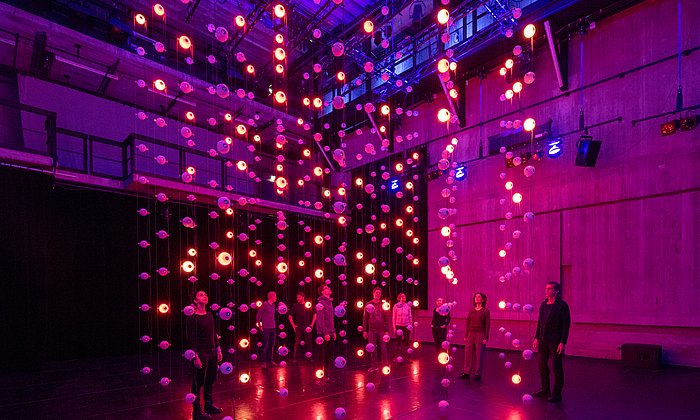Looking back on the Kunstareal Festival 2025
Science and arts in motion at the Kunstareal

Some danced, some simply lay on their picnic blankets in the evening sun and let themselves be enchanted by the sounds as glowing and rotating loudspeakers, created by artist Dr. Tim Otto Roth, were lifted into the sky in front of the Alte Pinakothek, just as they did on each of these warm June evenings of the Kunstareal-Fest 2025. With the three-day festival, the museums and institutions of Munich's Kunstareal celebrated this unique cultural location in the heart of the city on 27-29 June.
Linking science and art was the aim of this installation entitled "Sonic Revolutions", which had been initiated by the TUM Center for Culture and Arts and researcher Bernhard Seeber, Professor of Audio Signal Processing at TUM.
Sounds in motion
Even during the setup and initial test runs, the crane carrying the illuminated loudspeaker spheres had already attracted the attention of some visitors. Consequently, the creators had plenty of opportunities to connect with the audience.
"Analyzing, modifying, synthesizing and evaluating sounds," explains Prof. Seeber, "have been research topics at TUM for almost 60 years." This work of art now takes up older analysis methods, "and it builds a bridge to current research at the Chair of Audio Signal Processing," says Seeber. "To moving sound sources and to the analysis and synthesis of acoustic scenes in virtual reality."
"Sonic Revolution" can be experienced every evening in front of the Alte Pinakothek until Sunday, July 13. The highlight of the presentation will be an arrangement of Ludwig van Beethoven's "Great Fugue" op. 133 for the celestial carousel from July 11 to 13, 2025 under the title "Ludwig & Joseph - Beethoven meets Fourier".
Festival round the Munich city campus of TUM
TUM researchers, students and employees took part in the festival with a number of other contributions. They brought research, technology and social issues to life around the university's inner-city campus. In the TUM Architecture Museum in the Pinakothek der Moderne, there were talks on the current exhibition "TREES, TIME, ARCHITECTURE", which examines the potential of trees as living building elements. There were dance interventions, workshops and a science escape room.
Making Europe's stars shine
At the "Europe - Move Your Stars" light installation at the TUM School of Public Policy (HfP), visitors wriggled, danced and sprinted to set the stars of Europe in motion on a blue surface. This was made possible by two projectors connected to motion tracking, which lit up the outdoor area in front of the HfP, especially in the evening, accompanied by electronic music composed with the support of KI.
"Together with jink.one, we wanted to playfully address the topic of 'freedom' and encourage visitors to reflect on the power of democracy," explains Yvonne Holzmeier from the HfP.

TUM tanzt! creates new encounters
"TUM tanzt!" invited people to join in and discover new forms of movement. There were workshops, performances and discussions on all three days. Dance was presented as an art form and in a scientifically interactive way.
"It's a very special way to express yourself, to get in touch with yourself and others," says Lisa Lugo, who teaches Applied Sports Science. She had initiated "TUM tanzt!" together with her colleague Tina Schwender and Prof. Felix Mayer. It is a joint production at the interface of science and art, between Applied Sports Science at the TUM School of Medicine and Health and the Center for Culture and Arts (CCA).
Workshops on modern jazz, creative dance, hip hop and community dance moved students as well as festival guests young and old. In "roboTICKS", dancer Ludger Lamers met his robotic double in the matriculation hall and invited the audience to a lively discussion about human-machine interaction.
A special highlight: the "Ubuntu" project. Students from very different disciplines came together to form a dance company in just six days of rehearsals and presented a choreography in the Rotunda of the Pinakothek der Moderne. "That we can achieve much greater things by appreciating each other," was one of the most important insights from the project for choreographer Dr. Ellen Steinmüller from ExisTanz.
But it wasn't just the dancers who grew together and developed through this intensive experience - the audience was also amazed at the results. "Simply touching and admirable," someone wrote. "This intense focus on movement - and how easily everyone moved together."

Cracking the code of future energy in the escape room
Hands-on science: This was also offered by the Science Escape Room, which visitors could solve on Sunday as part of the family programme at the Mineralogical Museum. The game was developed by TUM students, doctoral researchers and employees, as well as members of the Cluster of Excellence e-conversion, for the Science Year 2025, which has the theme of 'Future Energy'.
'Escape from Carbonia' focused on this energy, exploring the fundamentals of renewable energy research and its impact on climate change. During this space mission, players of all ages set off in search of hidden clues, solving puzzles and conducting experiments — ultimately decoding a new technology for the energy of the future. This even made chemical formulas fun, as well as the band gaps of semiconductors and the surface structures of catalysts.
Technical University of Munich
- Julia Ripke, Yvonne Holzmeier, Kolja Kröger
- engage@tum.de
Contacts to this article:
TUM Center for Culture and Arts
Prof. Felix Mayer
Augustenstr. 44, 2nd floor
80333 Munich
info.cca@lll.tum.de


